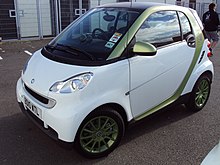The Smart fortwo electric drive (or smart ed) is a battery electric vehicle version of the Smart Fortwo micro car. This electric car was formerly known as Smart fortwo EV. Field testing began in London with 100 units in 2007, followed by Berlin in late 2009, and then the U.S. in January 2011 with 250 units, which are part of 1,500 cars that will be tested in several European cities, Canada and selected markets in Asia. Mass production is scheduled to begin in 2012 and it will be available in almost 40 Smart markets.
First generation
 |
| A Smart ED Police Car in central London. |
The first Smart electric drive vehicles were modified by Zytek Electric Vehicles. It is powered by a rear-mounted motor driving the rear wheels. It runs on 13.2 kW·h of sodium-nickel chloride Zebra batteries.
Field testing began in London with 100 vehicles in 2007 and was available only for lease to corporate clients for £375/month.
Specifications
Power: 30 kW (41 hp)
Economy: 12 kWh per 100 kilometers (193 Wh/mile)
Range 110 kilometers (68 miles)
Recharge time (80%): four hours
Recharge time (100%): eight hours
Top speed: 120 kilometres per hour (75 miles per hour)
Second generation
Production of the second generation Smart fortwo electric drive began in November 2009 in Hambach, France. These use a lithium-ion battery from Tesla Motors with capacity of 14 kW·h. The range of a fully-charged battery is up to 135 kilometres (84 miles) (New European Driving Cycle (NEDC) cycle).
As part of a three phase roll-out program, phase two began with field testing in Berlin in December 2009 with 100 units out of 300 that will be deploy in Germany. For phase two 1,500 cars will be produced and field testing is scheduled to be conducted in Hamburg, Paris, Rome, Milan, Pisa, London and the Midlands, Madrid, Zurich, Portugal, Denmark, the Czech Republic, Austria, Belgium and the Netherlands during the first half of 2010. In October 2010, 250 units will be available for field testing in several cities in the U.S.; testing will also be conducted in Canada; and in 2011 in selected markets in Asia.
Phase three will be mass production which is scheduled to begin with the 2012 model year. In the U.S. sales will begin in 2012 with the 2013 model year.
There is also a Brabus-tuned concept car.
Specifications
Power: 20 kW (27 hp) continuous; peak power output of 30 kW (40 hp) for approximately 2 minutes
Torque: 120 newton metres (89 ft·lbf)
Battery capacity: 16.5 kWh lithium-ion battery
Economy: 12 kWh per 100 kilometers, also reported to be 0.2 kWh/mile
Range 135 kilometres (84 miles) on the (NEDC cycle)
Top speed: 100 kilometres per hour (62 miles per hour)
The lithium-ion battery pack takes three hours to charge from 20 to 80 percent of its capacity with a standard 220V outlet. It can also can be charged using a common household 110V outlet. The car has a 3.3 kW on-board charger for this "level 1 and 2" charging. Smart claims a 0-to-60 kilometres per hour (37 mph) time of 6.5 seconds, the same as for the gasoline version. It has a single fixed-gear ratio transmission and is about 308 lb (140 kg) heavier than a gasoline-powered Fortwo.
United States
The trial program in the U.S. began in January 2011 with the first customer delivery in Washington, D.C.. A total of 250 units are available for leasing at a price of US$599 per month for a period of 48 months and 60,000 kilometres (37,282 mi), plus US$2,500 due at signing. This pricing is before taxes or any government tax credits or rebates available. Daimler announced that U.S. sales are scheduled for January 2012.
The limited fleet of second generation Smart fortwo electric drive cars will be introduced first in Portland, Oregon, Los Angeles, San Jose, California, Orlando, Florida, Austin, Detroit, Indianapolis and the I 95 corridor between Washington, D.C. and Boston, including New Jersey and New York.
Considering an energy consumption of 39 kWh per 100 miles (878 kJ/km) and a conversion factor of 33.7 kW-hr of electricity being the energy equivalent of a gallon of gasoline, the U.S. Environmental Protection Agency officially rated the Smart ED combined fuel economy at 87 miles per gallon gasoline equivalent (mpg-e) (2.7 L gasoline equivalent/100 km; 104 mpg-imp gasoline equivalent), 94 mpg-US (2.5 L/100 km; 113 mpg-imp) city and 79 mpg-US (3.0 L/100 km; 95 mpg-imp) highway. EPA's official all-electric range is 63 miles (101 km), but in favorable conditions in an urban environment at warm temperatures the carmaker claims the Smart fortwo ED can reach up to 98 miles (158 km).
(source:wikipedia)





No comments:
Post a Comment